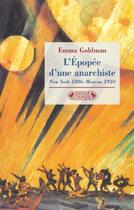-
Date de parution : 27/06/2023
-
Editeur :
Culturea
-
EAN : 9791041802715
-
Série :
(-)
-
Support :
Papier
Résumé:
In 1919, at the height of the anti-leftist Palmer Raids conducted by the Wilson administration, the anarchist activist and writer Emma Goldman was deported to the nascent Soviet Union. Despite initial plans to fight the deportation order in court, Goldman eventually acquiesced in order to take... Voir plus
In 1919, at the height of the anti-leftist Palmer Raids conducted by the Wilson administration, the anarchist activist and writer Emma Goldman was deported to the nascent Soviet Union. Despite initial plans to fight the deportation order in court, Goldman eventually acquiesced in order to take part in the new revolutionary Russia herself. While initially supportive of the Bolsheviks, with some reservations, Goldman's firsthand experiences with Bolshevik oppression and corruption prompted her titular disillusionment and eventual emigration to Germany.
In My Disillusionment in Russia, Goldman records her travels throughout Russia as part of a revolutionary museum commission, and her interactions with a variety of political and literary figures like Vladimir Lenin, Maxim Gorky, John Reed, and Peter Kropotkin. Goldman concludes her account with a critique of the Bolshevik ideology in which she asserts that revolutionary change in institutions cannot take place without corresponding changes in values.
My Disillusionment in Russia had a troubled publication history, since the first American printing in 1923 omitted the last twelve chapters of what was supposed to be a thirty-three chapter book. (Somehow, the last chapters failed to reach the publisher, who did not suspect the book to be incomplete.) The situation was remedied with the publication of the remaining chapters in 1924 as part of a volume titled My Further Disillusionment in Russia. This Standard Ebooks edition compiles both volumes into a single volume, following the intent of the original manuscript.
Donner votre avis















